https://www.youtube.com/watch?v=rgXtLVFzFmo
The Perfect Steak Every Time With These 3 Techniques
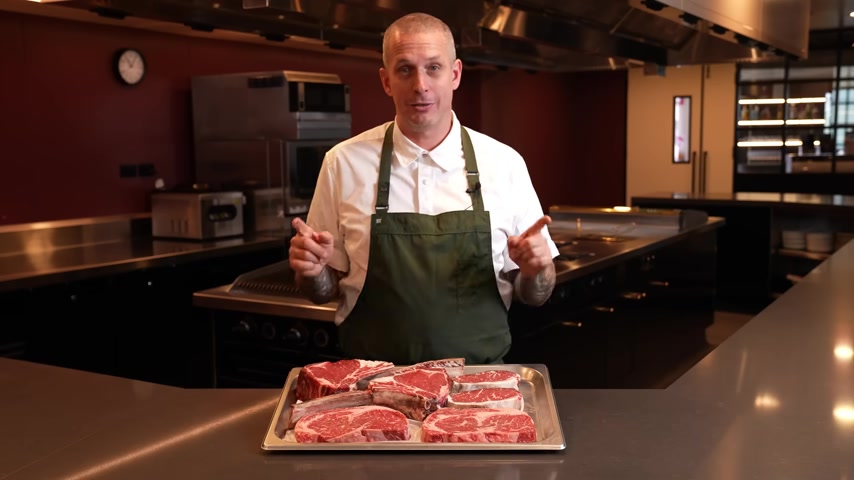
Alright , we're back and we're in my work test kitchen Kil Coy global foods .
And I wanna answer the questions I get asked all the time is how to cook the perfect steak .
Now I wanna start by making the caveat that there's no perfect way .
There's lots of different ways .
If you've got a technique that you think works well , then please leave it in the comments below because we'd love to hear about it .
So today we're gonna run you through a pan .
Sead Ebony Angus , Sirloin .
This has been dry aged .
It's a bit darker than normal .
We're gonna do a grilled Carrara Wau Ribo , and we're gonna do a reverse sear on one of these blue diamond tomahawks .
Now , these , uh , methods are all kind of interchangeable .
You can use them for different cuts .
Some work better than others .
Like I think reverse searing only really makes sense in big cuts .
But we'll talk through that soon .
Let's get stuck in before we cook anything we need to talk about temperatures .
The most important thing so rare .
Your 105 F 40 C , medium rare 15 F 46 C medium 1 25 F 52 C medium well , 1 35 57 and , if so , are well done .
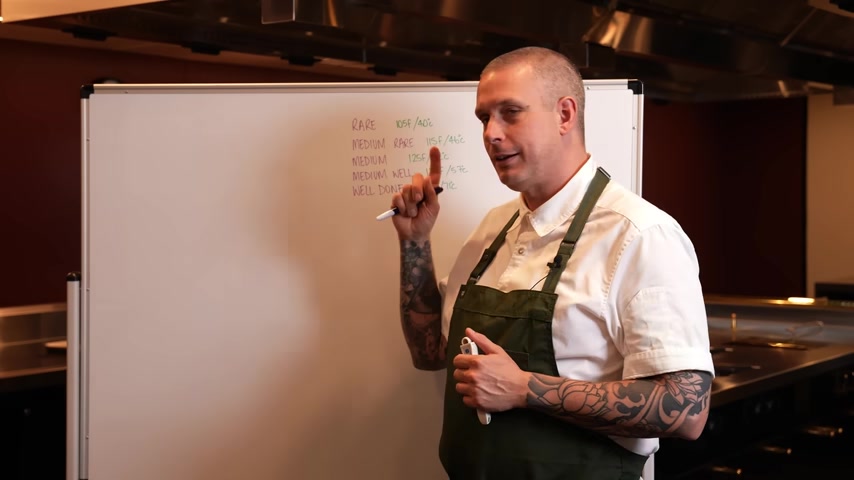
It's 1 , 60 or or 71 C .
So this is the temperature that you pull it off the heat source and let it rest .
Also the same with reverse searing .
But we'll get into the the kind of nuances with that later on .
But you need one of these .
I bang on about this .
All this time .
You know people that say , Oh , I can I can touch a steak and know what temperature it is .
That might be true if you cook hundreds of steak a night .
If you don't cook hundreds of steak a night , just excuse one of these .
It's way easier .
Let's get stuck into the first one .
Alright , pan searing a steak so you ideally want skill .
It something like this cast iron , heavy , well seasoned and then your steaks .
This works really well with rib eye or sirloin or ed or filler , any kind of cut that's not massive , like the Tom Hawk we're gonna do later .
There's a lot of argument at the moment about whether you temper steaks or not bring it up to temperature or room temperature , I can assure you most restaurants around the world cooking steaks of this size do not temper their steaks .
They come out of the fridge and they go in the pan onto the grill and I do the same thing .
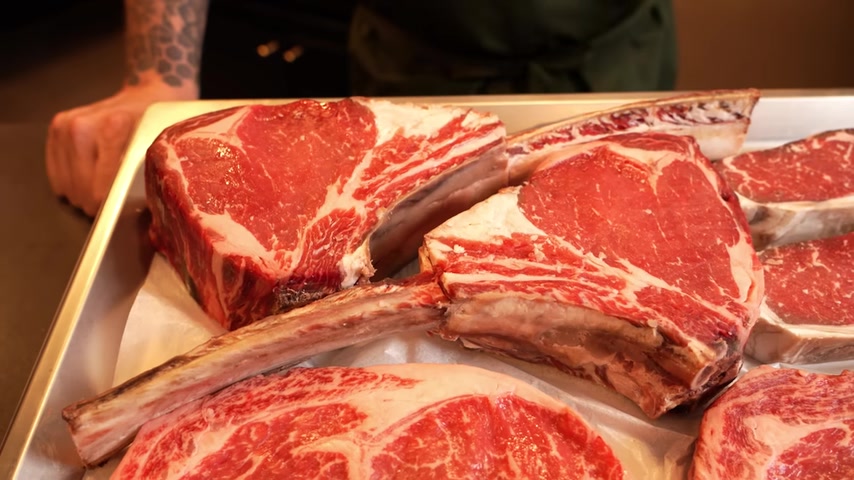
However , if I'm doing a big cut of meat like a tomahawk , I do tend to temper it now .
I don't have any science to back up Why I do it .
I just do it out of habit .
Alright , I've had to turn the extraction on , so it's a bit loud .
First thing's first , this pan's hot .
Get some oil in it and don't be shy .
I add a add a good amount of oil .
Season our steaks with salt .
I'll talk about why I don't use pepper in a minute .
The season it on all sides .
Alright , we can see that the oil is starting to smoke .
Time to get these in .
First things first .
Fat cat down .
What that does is render that fat .
You see they get colour already .
Let's get the other side Now the flat face down and we're gonna keep turning these .
We're gonna turn them about every 30 seconds or so and that way we get really nice , even charring .
We're looking for a deep red , almost brown nutty colour on all the way on the outside .
Now , like I was saying before , these steaks are dry aged .
So this would have been further down the end , probably the first steak off the end .
So it's drier .
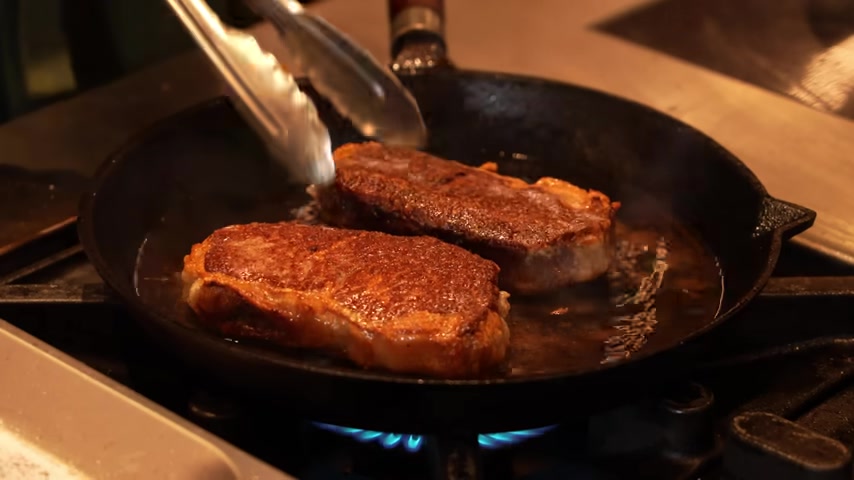
Once it's drier , it's gonna like caramelise , Uh , quicker .
Now you can see here .
I'm really happy with this colour .
It's time to add some butter to the pan , so ice cold butter , few cubes .
And then to that some rosemary .
And I got some garlic cloves here so these garlic cloves aren't peeled , it's gonna smash them , and then they go .
So we're gonna base these steaks in that foamy butter , and that's gonna really amplify the caramelization that we've got on the outside .
Now I know someone's gonna come in the comments and say , That's not caramelization .
I know it's technically not caramelization , but that's what we refer to it as .
At this point , you really need to start making sure you check the temperatures because they can go over really quickly .
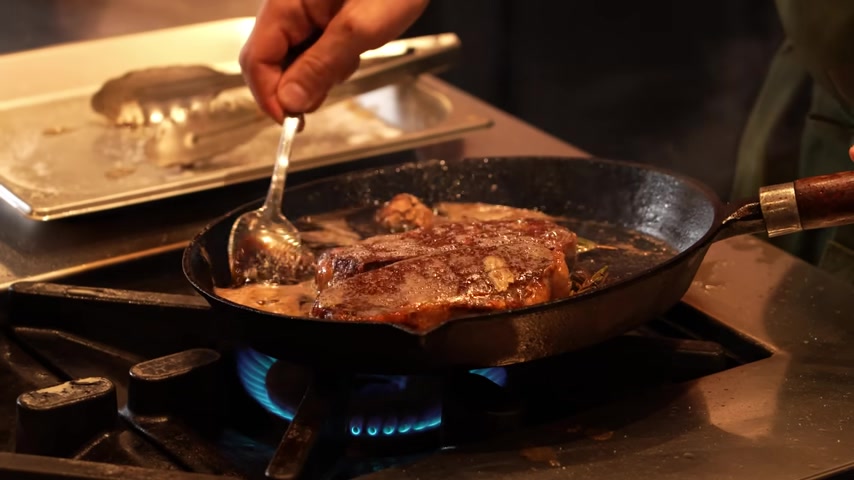
So this one here is about 34 degrees and this one's a bit hotter .
It's about 35 degrees , but this will all happen pretty quickly now .
Keep turning .
Keep basting until you reach that internal temperature that you're looking for .
So we've got a tray with a wire rack ready .
That's really a rest them .
I think we're just about there and you've probably noticed I've turned the flame off and that's because this pan is getting too hot .
Alright , take them off .
Let him rest .
Now you can pour a bit extra of that butter over .
We'll let those rest for a good five minutes and then we'll cut it open and see how I did .
So there you go , medium rare .
No Grey Band on the outside .
It's not running juices everywhere .
What ?
And Super Tender ?
This has to be one of my favourite ways to cook a steak , but let's get on to grilling .
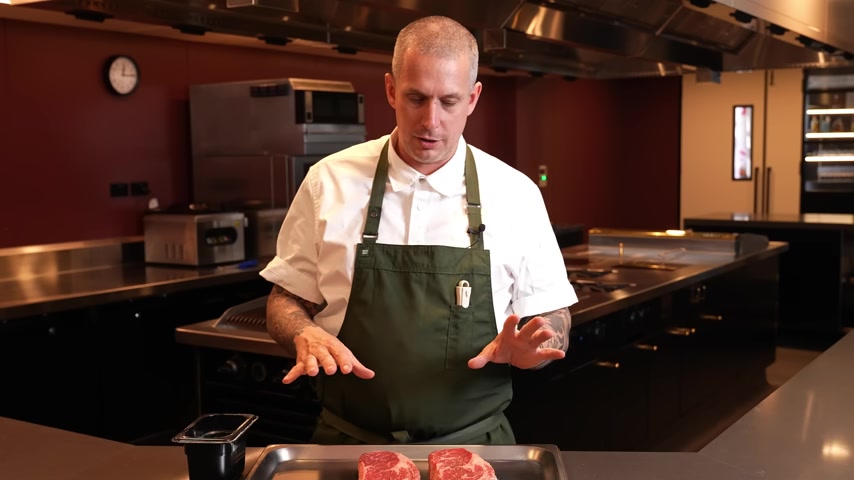
Alright , grilling steaks Now .
This applies to whether you've got a gas barbecue outside .
Uh , anything with the grill lines in it .
I've only got gas here .
Charcoals preferred , but we're indoors .
So , uh , we'll make do with what we've got .
So I got a couple of really nice wao rib eyes .
These are marble score six or seven ?
I think so .
A really good marble score for for steaks like this .
I think once they get much higher , they become too rich .
That's another video .
But I wanted to really touch on seasoning .
So , uh , here in Australia , it's main .
Most people just season with salt and pepper .
Personally , I don't use pepper either .
I kind of prefer to put my pepper on after freshly cracked .
I don't really like how the pepper kind of burns a bit and and , uh , yeah , it burns and taints a bit .
So I'm I'm a purist .
I just use salt .
I know in a lot of other parts of the world , especially through North America , people like to season their steaks with barbecue rubs and and steak rubs .
Um , by all means , this is the point that you do that as well .
For me personally , I don't think it needs a delicious , really high quality meat .
I think it just needs salt .
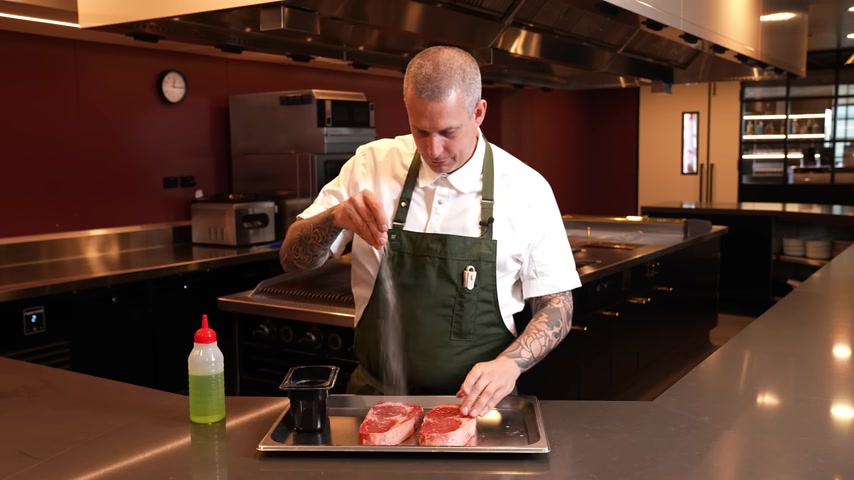
So for the grilling , unlike the pan searing , we're gonna oil our steak first , so get a decent amount of oil on the outside , rub it over , and then we season with salt and make sure you've got a salt , a clean hand for your salt and your dirty hand for your steaks .
So season them with salt on one side , generous as well .
Most of it will come off when you hit the grill anyway , so don't be afraid to whack it on there and then the type of salt you use .
We use what we call kind of table salt still sea salt so it's still evaporated from salt water .
Um , not the flaky finishing salt .
Josh Wiseman gets angry when you use that you've got a big problem .
People keep using leaky salt to season stuff before it's cooked .
Josh is completely right in restaurants .
You don't use that salt because it's really expensive , and this stuff's a lot finer .
So you get the more even coverage .
All you've got is flaky salt .
There's nothing wrong with using that as well .
Anyway .
We've sold of these time to to get to them on the grill , so grills on maximum use your hand to find the hotspots .
All grills have hotspots .
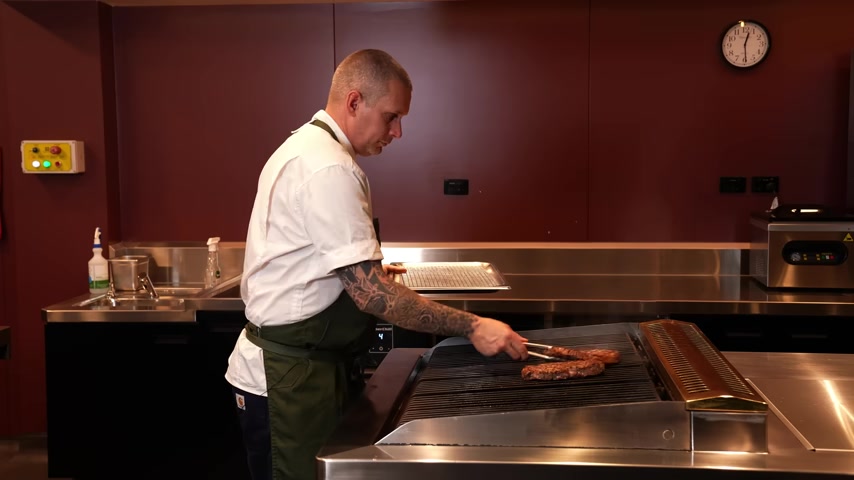
This one's hotspots right here , and that's where we want to go first .
Put your steak down and like all the other states , temperatures are saying we want medium rare .
We're gonna pull this off about 45 46 degrees Celsius .
So when grilling a steak , don't get caught up and having perfect bar lines .
Unless you're doing competition barbecue where it matters .
It's actually more important , I think , to get more bar lines on there .
The more bar lines , the more contact you have with the grill .
Uh , means more flavour , more colour , more flavour .
Pretty simple .
And when flipping , make sure you move it to a different spot in the grill if you can .
So these steaks , the rib eye , are my favourite steak to have at home .
Uh , because of the fat content , they've got this nice nugget of fat in the middle .
Pretty good marbling .
Alright .
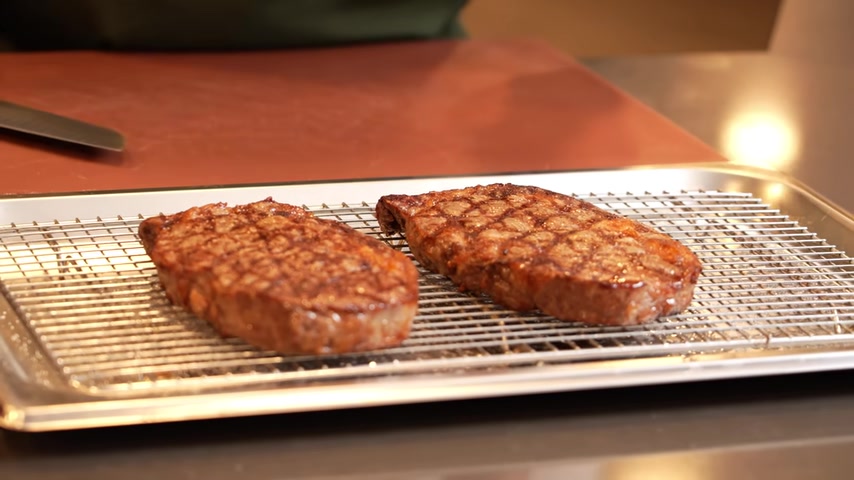
So the truth is , I would like more colour on these , but it came up to the temperature we were looking at , so we had to pull it off .
So how do we get around that ?
Well , we need our grill hotter so that grill is as hot as it can go .
I'm not sure why it it's not up to temperature today .
It's been on for about two hours , so it should be more than up to the temperature .
But , hey , it shouldn't be overcooked , but I would like a bit more colour on the steak .
So if you've got a grill at home , make sure it's cranked as hard as you can .
Or if you're lucky enough to be able to do it over charcoal , then make sure you've got a really good bit of of , uh , of coals before you start cooking your steak .
Let's carve one of these open and see how it looks .
Does the steak cuts like butter ?
Beautiful , Medium rare .
How does it taste ?
Mhm .
That's delicious .
Honestly , you don't really miss that extra , you know , car in the mouth feel , but definitely visually .
It could look a bit , um , a bit more caramelised anyway , on to the last one .
The reverse air Tomahawk .
Alright , Time to reverse .
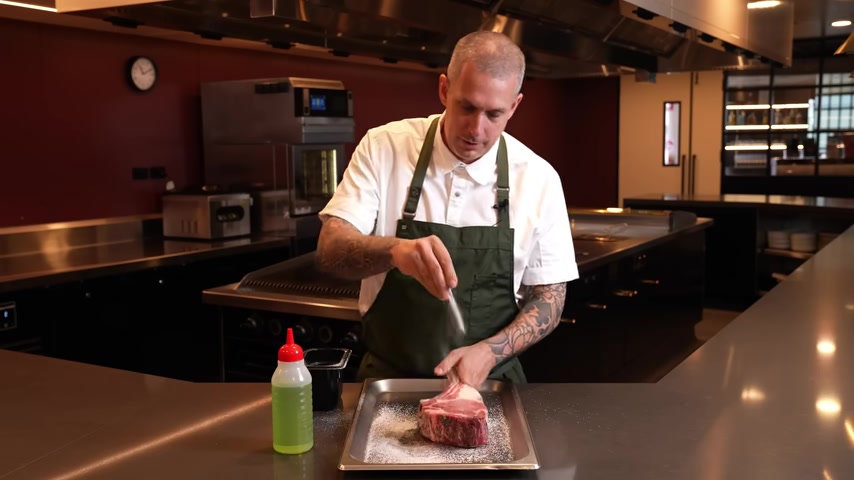
Sear this tomahawk , and it's a good time to talk about seasoning .
And now you've probably heard of a technique called dry brining at the at the moment .
So dry grinding is when you season a steak , Uh , about 24 hours or four , and you put this on a wire racket and leave it in the fridge .
What happens is the salt dissolves into a liquid and then basically penetrates the protein muscle .
It's definitely a very worthwhile option .
There's nothing wrong with doing it , but it's not the end of the world if you haven't done it .
And I wouldn't recommend wet brining , which you see quite a lot in things like chicken .
So be really generous with your salt .
Uh , like I was saying before , I'm not a huge fan of cooking meat with pepper .
I put it on after now off to the oven .
So to cook this , it's better to cook it on a rack if you have it , and then we're gonna get it in the oven .
Alright , so that oven is set to 100 and 10 Celsius , which is about 2 30 F on fan force .
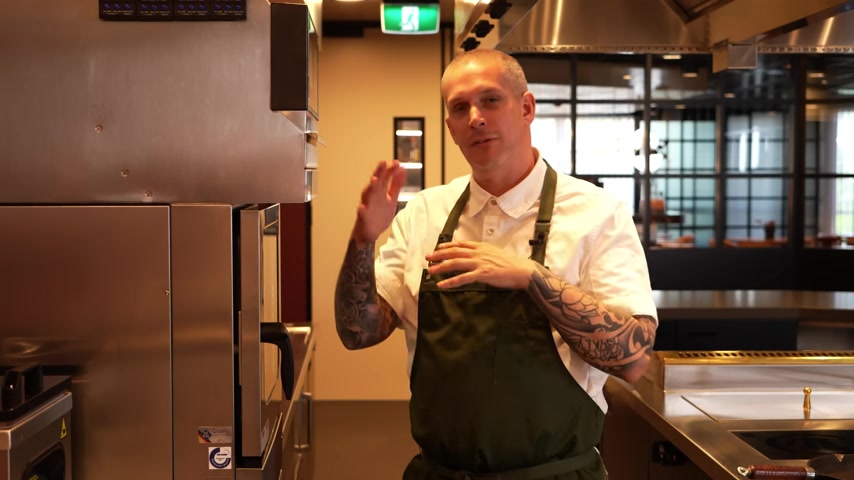
I know if you are from the kitchen world , you see that this is a like a combination oven .
There's no steam set .
This is just dry heat like you'd have at your home oven .
So it's the same temperature , and I want to cook this to kind of medium rare , so we're gonna pull this out of about 46 degrees Celsius .
It'll continue cooking another maybe five degrees when it's resting , and then we're gonna seal it off .
Alright , so we're about 45 46 degrees Celsius in the centre .
We want to rest this for a good 10 to 15 minutes .
It doesn't look super appealing .
I know it looks a bit grey , but that's what this next step is all about .
So to get the the the outside colour , you can either do it in a pan like we're about to do here .
Or you could do it on the char grill like we did with the last stack .
So this was in the oven at 100 and 10 degrees for about 35 40 minutes in total .
But that will vary on your oven .
The fan speed the temperature of the sake when it went in .
So make sure you're looking at the internal temperature , not the time or the oven temperature .
Now , what we're doing here is getting this really hot , and we're gonna seal the outsides if you're gonna do it on a char grill .
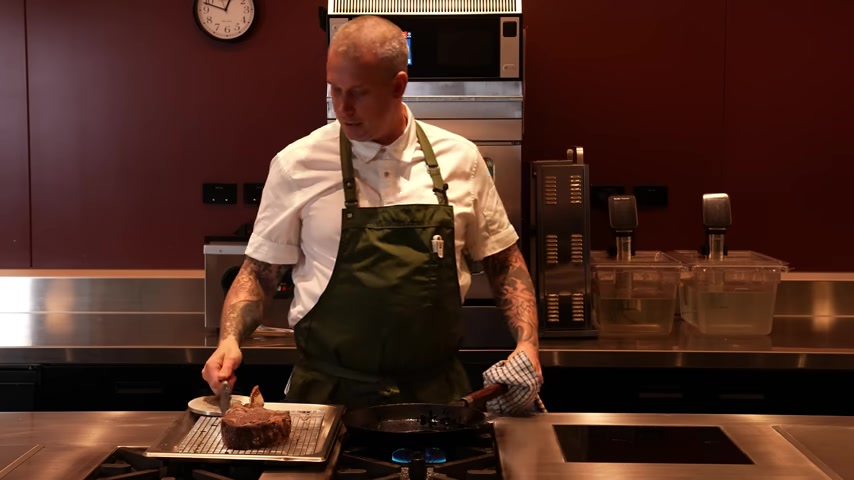
You know , boil this outside first cos we're doing it in the skillet we're gonna oil the skillet first decent amount of oil , and we're actually gonna use a burger press to help press this in a bit .
Uh , you don't wanna push heaps of pressure on because you'll lose a bit too much moisture , but just a little bit of pressure will help you get a more even colour on the outside .
It's also worth noting it's probably better to have a bigger skillet than I've got here .
But I didn't bring my big boy from home , so , uh , I was intending on using the grill .
But as we saw on that last video , uh , for some reason , that grill is not getting super hot today .
So we'll get this pan ripping hot , and then we'll get this Tomahawk in there .
They don't put heaps of weight on that .
You just want the weight of the press itself , just holding it down nice and flat on the surface .
If you don't have a burger smasher , another fry pan works just as well for you .
And if for whatever reason , you don't have a pan or a barbecue to seal this , you can crank your oven up as high as it will go and do it in there .
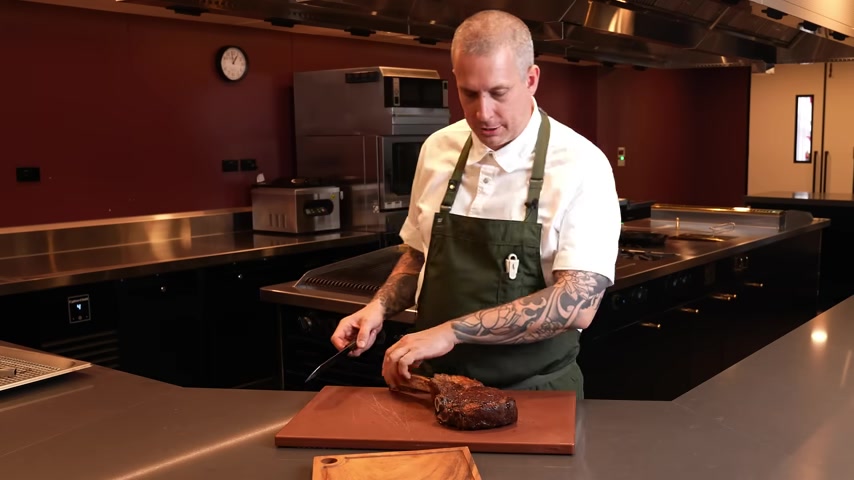
But be warned , it will get smoky and your oven will need to be cleaned .
Alright , It's only taken about 4 to 5 minutes and we've got good colour time to take it off now because this has already rested when it came out of the oven .
We don't need to wait so straight into carving , let you turn the extraction off , mate .
Yeah , that's better .
I can hear myself think so .
This is a tomahawk .
It's basically a ribo like we had in the last video to carve this .
All we're gonna do is carve down this bone here and we'll leave that to one side , and then we're just gonna slice it .
Nice , big slices .
Ideally , you want to get some of this part here , which is the eye ?
Some of this part here , which is the outer muscle , all in one piece .
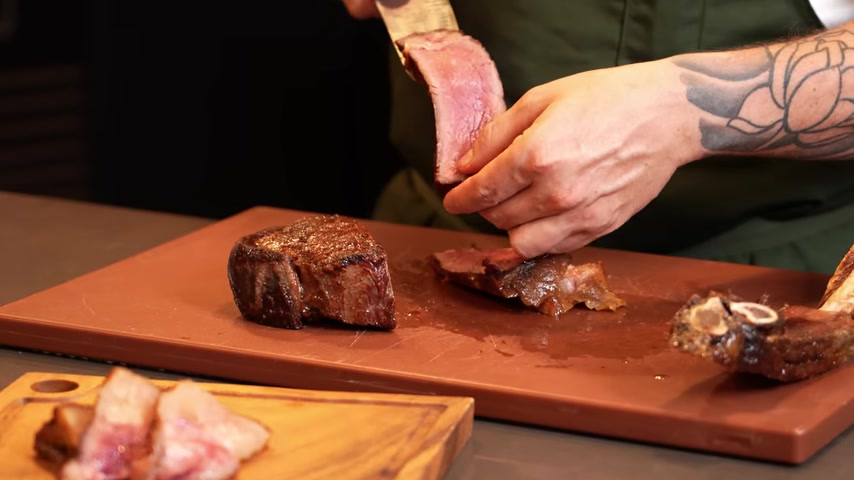
I like to take those first three bits off first , which is usually you got a really large piece of fat in there and we use that to prop the rest of it up , and then we can get some big slices and you can see the benefit already of doing a reverse sear .
This isn't bleeding out at all .
And we've got a perfect medium rare and a really thick piece of meat all the way through .
And this is when you do use flaky sea salt .
Flaky salt is for finishing .
There you go .
Reverse , said Tomahawk .
How good does that look ?
I guess we better taste some .
Even though I've been in my own body , weight and meat today , this is dry aged Blue Diamond .
Oh , that's delicious .
I love how consistently reverse searing cooks meat .
It's incredible .
Now , as I said at the start , there's no right or wrong way to cook steak .
So leave in the comments how you cook your steak .
I think with these three methods , you're gonna bound to find something that , uh , suits your budget .
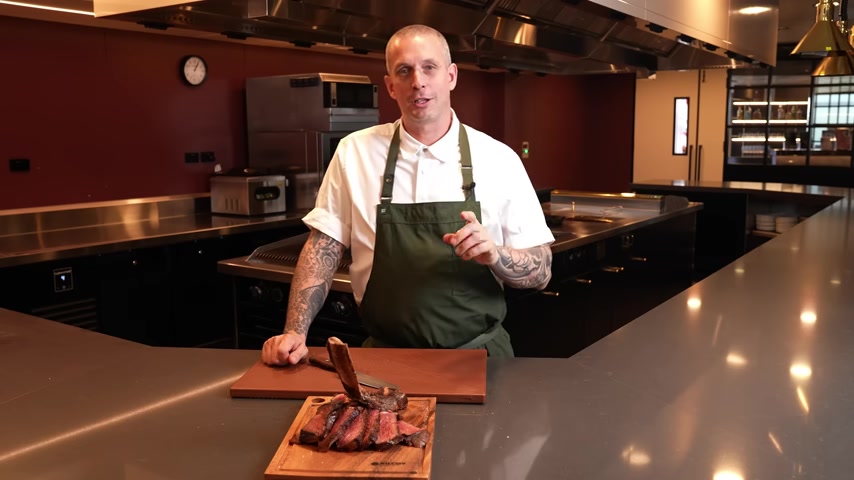
Uh , your kitchen style , what you've got .
I'm not at home .
Try one of them .
Try them all .
Let me know how you go .
If you enjoyed this video , then check this video out because you're gonna need something to serve it with .
These are my hero sides on Christmas , but they work just as well any other time of the year .
Thanks for watching .
Subscribe if you're not like if you took anything from this video and we'll see you next week for another recipe Peace .
Are you looking for a way to reach a wider audience and get more views on your videos?
Our innovative video to text transcribing service can help you do just that.
We provide accurate transcriptions of your videos along with visual content that will help you attract new viewers and keep them engaged. Plus, our data analytics and ad campaign tools can help you monetize your content and maximize your revenue.
Let's partner up and take your video content to the next level!
Contact us today to learn more.